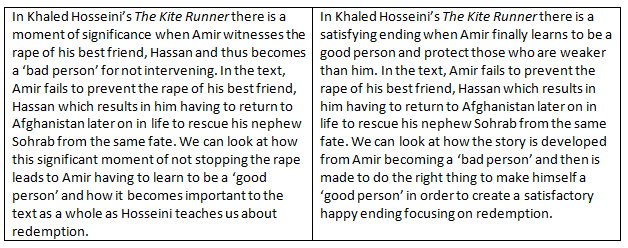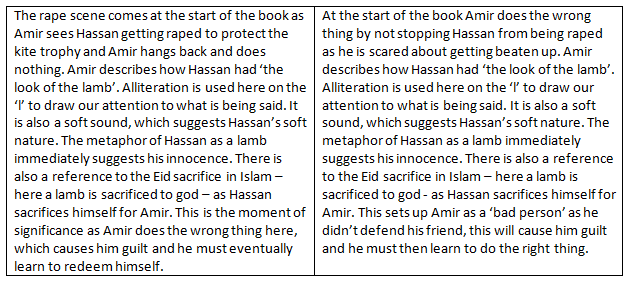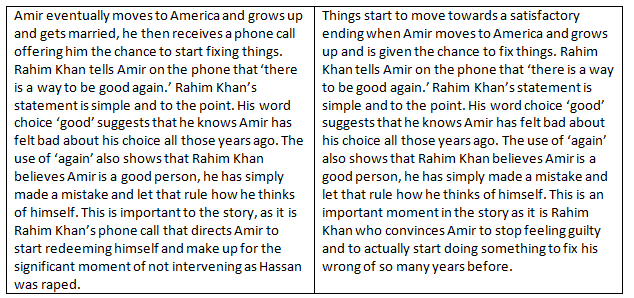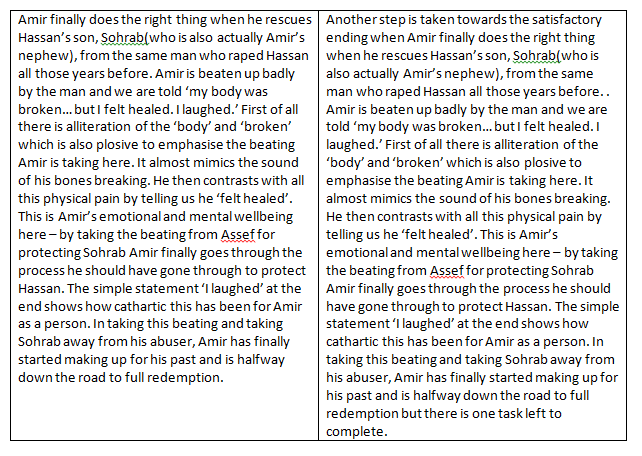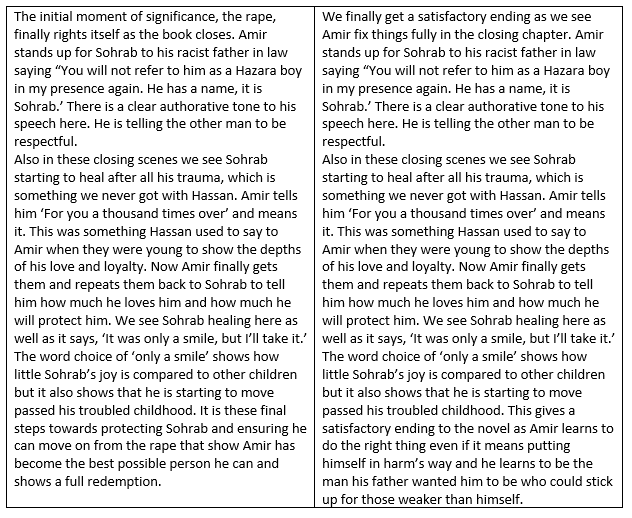colour-coded PEEL Estella essay
Below is the Estella essay without the colour-coding. The word document option will help you see the structure more clearly.
Great Expectations by Charles Dickens features the character Estella whose complexity lies in the fact that she is Miss Havisham’s adopted puppet, created to break men’s hearts as revenge for her mother yet we feel sympathy for her as she does not understand how to behave in any other way. The novel follows Pip as he falls in love with Estella, rises from poverty to riches at the hand of a mysterious benefactor before finding himself and his purpose in life as a young man. We can discuss how Estella’s complexity helps us understand Dicken’s wider point of being a good person in life.
We first meet Estella at Satis House when Pip goes there to ‘play’ with her at Miss Havisham’s invitation – really he is Estella’s first toy to test her emotional manipulation abilities and show us how she influences Pip’s personality. She flexes these manipulation muscles in her first meeting with Pip where he tells us, “her contempt for me was so strong, that it became infectious, and I caught it.” Here the word choice of ‘contempt’ shows that Estella truly hates Pip. The metaphor of it becoming ‘infectious’ eloquently shows that Pip’s own feelings towards himself change. Estella’s actions cause Pip to dislike himself as a person. He ‘catches’ the ‘contempt’ for himself and starts to judge himself and his background cruelly. Estella does this because she has been brought up to think less of those around her. Estella’s meanness to Pip is the trigger for him to change from a pleasant boy into a snob who criticises himself, she is the trigger for Pip to stop being a good person.
This change in Pip’ s personality continues at their next meeting when Pip fights a boy outside Satis House and catches Estella watching. Pip again tells us, “there was a bright flush upon her face, as though something had happened to delight her”. Estella’s reaction here is disturbing as she seems to be excited by the physical violence, the ‘flush’ hints at a sexual excitement too, she is being trained to delight in others pain – a sadist. This is the first clear sign that Estella thrives on seeing others hurt. She is even seen to reward Pip for fighting by granting him a kiss. This shows her manipulating him, by encouraging his affections for her and suggesting that she needs physical protection in some way. This scene adds a complexity to Estella’s character as it shows she is capable of enjoying things rather than keeping herself neutral to everything. It also adds to the whole story as the event further deepens Pip’s feelings for Estella leading him further into a personality that does not always display positive traits.
We start to feel sorry for Estella when it becomes clear that she is a broken person and Pip still tries desperately to make her love him. She tells Pip, “I have a heart to be stabbed or shot in, I have no doubt, and, of course, if it ceased to beat, I would cease to be. But you know what I mean. I have no softness there, no – sympathy – sentiment – nonsense.” Her words here shows she acknowledges her physical heart as something that can hurt or harmed, and she uses alliteration and plosive words to highlight this hurt – ‘stabbed’ and ‘shot’. They add aggression to her tone and make it sound like she is spitting her words at Pip. But then she disregards being able to feel emotions. She refers to these as ‘softness’ suggesting she thinks emotions are something that make you vulnerable. She shows further disdain for them with her list of words ‘sympathy’, ‘sentiment’ and then the final blow, ‘nonsense’. With that word she dismisses Pip’s feelings for her as trivial. In the same speech she also talks of never ‘bestowing her tenderness anywhere’ as she has never had tenderness. With such a statement Estella again refutes any warmth in her personality. There is an irony here though, as in telling Pip such things she is showing him a kindness in trying to warn him away. At this point we feel sorry for Estella, she is a cold-hearted being, because that is what Miss Havisham made her and she attempts to save Pip from her but he will not listen. He is still desperately set on believing the fairytale that Miss Havisham is his secret benefactor and that he is destined for Estella.
As Estella grows into an adult she actually goes against her maker Miss Havisham, much to the old lady’s shock and horror. Miss Havisham is appalled at Estella’s attitude when discussing her engagement to Drummel and Estella responds with “I am what you designed me to be. I am your blade. You cannot now complain if you also feel the hurt.” There is a continued theme here of violence that surrounds Estella. She compares herself to a knife here as both are sharp and can be used to hurt people – a knife physically, Estella emotionally. What Estella exemplifies at this point is how dangerous it is to interfere with people and shape them. She can commit Miss Havisham’s wishes but in doing so she is also hurting Miss Havisham. She does no good for anyone her, not for herself, not for Drummel, not for Pip and certainly not for Miss Havisham. In trying to achieve revenge, Miss Havisham has only hurt herself by cutting short Estella’s love for her.
There is some hope for Estella though, and even she, arguably the most broken character in the book finds redemption. Estella meets Pip at Satis House and reveals Drummel, her abusive husband is dead and she is free to remarry, she tells him, “I have been bent and broken, but – I hope – into a better shape”. Her word choice here is actually quite sad, although she is speaking metaphorically here about her change of character and says that she is a better person now she is also referencing that part of this change took place as a result of Drummel’s fists – ‘bent’ and ‘broken’. The words are also alliterative and plosive as if mimicking the sound of his raining blows. It is also plausible that Estella actually finds a happy ending after finding herself as we are told by Pip, “I took her hand in mine, and we went out of the ruined place; and… I saw no shadow of another parting from her.” The word choice of ‘ruined’ suggests that both characters accept the imperfections of their past but are prepared to move on from it, the holding of hands shows them finally in partnership and the lack of ‘shadow of another parting’ suggests they intend to be together. This ending shows us our protagonist achieving his happy ending, but it also shows that Estella, as a result of her changes to her life also receiving her happy ending with a man who will care for her and love her properly.
In conclusion, Estella is an immensely complicated character as a result of her upbringing at the hand of Miss Havisham who intends her to be a manipulative heart-breaker. Estella can quickly see that she is inhuman in certain aspects and thrives and gets excited from being able to control the men around her. She feels sorry for Pip though and attempts to protect him from her. This makes us sympathetic towards her as she attempts to protect our protagonist. We also know that her behaviour is not entirely her fault. She exemplifies Dicken’s theme of being a good person as she, like Pip, only gets her happy ending when she changes herself for the better.

